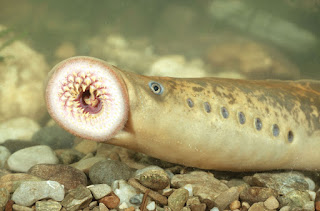
The sea lamprey is a primitive species of eel-like fish that spends part of its life in the sea and part in fresh water. It is native to the Atlantic Ocean and can be seen near the coasts of North America and Europe. In freshwater, the sea lamprey is native to the Connecticut River ecosystem. At the beginning of the 20th century, the sea lamprey managed to expand its habitat to the Great Lakes and Lake Champlain by migrating through the artificial canal system. Each new habitat attacks and depletes the native fish population and disrupts the natural balance of the ecosystem.
There are 38 known species of lamprey in existence. Scientists have recorded at least five of the 38 species.
Sea lampreys can reach 12 to 20 inches in length and 8 to 13 pounds in weight.
Sea lampreys have at least 12 rows of teeth arranged in circles around their mouths.
Sea lamprey has eel-shaped body that is slimy and naked. It is brown to black on the back and light yellow to light brown on the belly.
They have seven gill openings on each side of their bodies. Their gills lie behind their eyes.
Sea lampreys are jawless fish. They have large, reddish eyes and single nostril on the top of their head.
Lampreys have a single nostril at the top of their heads.
Just like other fish, sea lamprey breathes using the gills. It has seven gill openings that are located behind the eyes.
Adult lampreys have long, slender, and scaleless bodies, making them look superficially similar to eels.
Sea lampreys are easily recognized by the large mouth, filled with circular rows of teeth. They are designed for sucking.
The sea lamprey, for example, is also called the vampire fish, because of its blood-sucking feeding method.
Sea lamprey is feeding by sucking blood and bodily fluids of other fish. They will attach mouth to the prey like a vacuum cleaner. Sharp teeth and rasping tongue easily damages the prey’s skin and induces blood flow.
Similar to leeches, lampreys secrete enzymes that prevent the blood of their prey from clotting.
Larger fish might survive attack of sea lamprey, but smaller usually dies due to serious wounds or subsequent infections.
Today, the Great Lakes Fishery Commission coordinates control of sea lampreys in the lakes, which is conducted by the U.S. Fish and Wildlife Service and Fisheries and Oceans Canada.
Sea lamprey usually attacks white fish, trout and chub. Besides fish, sea lamprey feeds on small invertebrates.
Due to their similar body shapes, lampreys are sometimes inaccurately called “lamprey eels.”
Sea lamprey also uses its mouth to attach itself to the stones and take a rest during migration from marine to fresh water.
Unlike “bony” fishes like trout, cod, and herring, lampreys lack scales, fins, and gill covers.
Sea lamprey spends around 10 years in the fresh water. After that time, it migrates to sea, where it stays usually around 2 years. During that time, sea lamprey will become mature and it will return back to fresh water for spawning.
Like sharks, Sea lamprey’s skeletons are made of cartilage.
Spawning takes place in the spring. Sea lamprey can deposit as much as 100 000 eggs in the stony nests. Sea lampreys will die immediately after spawning.
Sea lampreys can live in saltwater or freshwater.
A lot of eggs deposited by sea lamprey serve as food for other fish in the water.
Sea lampreys often migrate during their lives from one habitat to another.
Sea lamprey can induce significant damage to an ecosystem by killing large number of native fish species.
On average only about 1 in 7 fish will survive a lamprey attack.
For that reason, people use chemicals, electric fences and dams to prevent uncontrolled spreading of the sea lampreys toward sensitive rivers and lakes.
Although sea lampreys are major predators, they also spend time resting on rocks and other surfaces.
Sea lampreys can be fished and used as delicacy in certain European countries.
An average lamprey kills about 40 pounds of fish in a year.
Average lifespan of sea lamprey is 14 years.
The sea lamprey’s strongest sense is its sense of smell, which it uses to communicate.









